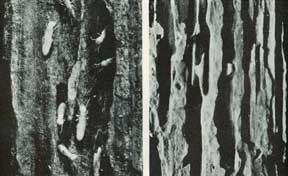The Terrible Termite, Page 2
By HUGH SPENCER
Page 1 | Page 2
The workers are blind miners eating endless galleries in the dark interior of old wood, toiling tirelessly with an industry and perseverance that would be commendable if it did not so often undo the handiwork of man. In the digestion of this insoluble material the termites are assisted by countless microscopic protozoans that inhabit their intestines. They vary this diet of wood cellulose by occasionally eating their own excrement and the cast skins and dead bodies of other termites. The worker eats not only to satisfy his own appetite but also to nourish, by regurgitation, the young nymphs, queens, males and soldiers of the colony. The workers also excavate underground tunnels and build runways of cement in exposed places.
Like the workers, the soldiers are blind and sterile. Their only function is to police the colony and keep out ants and other invaders. Owing to the structure of their jaws they are unable to eat wood and must be fed by the workers.

THE "LITTLE CHISELERS" BURROW AND TUNNEL THROUGH WOODWORK
The queen in her royal chamber is little more than an egg factory. Some colonies have supplementary queens. These lay eggs that produce workers or secondary reproductive forms, and they contribute largely to the rapid increase of the family.
At the time of the annual flight, usually in early spring, the young males and females, dark brown now with slender, lacy wings, swarm out of the nest and take flight. Many of these perish, but those few that succeed in finding mates and suitable locations start new colonies after discarding their wings. The presence of these flying termites is an almost certain sign that there is a termite colony in the vicinity.
Our common termite of the eastern United States is a subterranean species. It lives, usually, in the ground or in wood in contact with the ground. It can live in dry wood only when it can maintain connections with the ground or with other sources of moisture. At times it will build enclosed passages over concrete or stone foundations to reach a food supply but such passages rarely go more than a foot above the soil. Entrance to houses is usually through wooden porches, sills of cellar doors or windows, or other woodwork in contact with the soil. In their wood-mining operations the termites are careful to leave the outer shell of the wood intact, consequently a great deal of damage may be done to a building before there is any visible evidence of their presence.
Methods of protecting buildings against termite invasion are described in bulletins published by the D. S. Department of Agriculture and by the agricultural departments of many states.
For the purpose of study and observation in schools and elsewhere, termites may be kept in a "termite nest". This consists of two panes of glass separated by strips of glass around the edges and held in place on a board by wooden cleats. Soil, food and termites are introduced by removing the strip of glass at one end. This miniature colony will thrive for months if humidity is maintained by adding a few drops of water from time to time.
Page 1 | Page 2
 Printer-friendly version
Printer-friendly version
